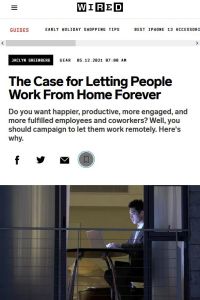Join getAbstract to access the summary!

Join getAbstract to access the summary!
Jaclyn Greenberg
The Case for Letting People Work from Home Forever
Do you want happier, productive, more engaged, and more fulfilled employees and co-workers? Well, you should campaign to let them work remotely. Here’s why.
Wired, 2021
What's inside?
As the pandemic winds down, the office beckons. Will your company heed the call?
Recommendation
Post-pandemic, will you go back to the office or continue working from home? When her son was born with disabilities, Jaclyn Greenberg made the hard choice to quit her office job. In this article, she muses about what might have been, and what could still be for employees, now that the COVID-19 pandemic has proved the viability of remote work. While some extroverts might insist upon going back to the office, most employees, it seems, prefer flexible options. Greenberg offers a compelling argument for the benefits of remote work.
Summary
About the Author
Jaclyn Greenberg is a freelance writer. Her work has appeared in the Huffington Post, Parents magazine and Wired, among other publications.

















Comment on this summary